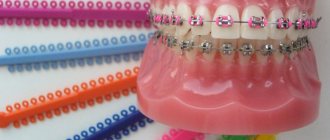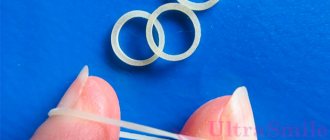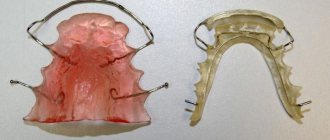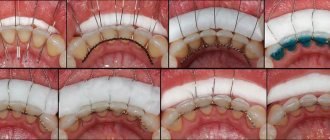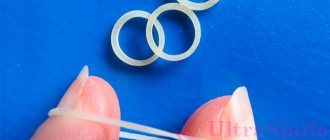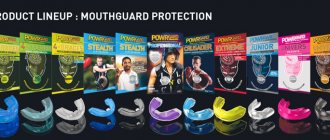Correcting a bite is a complex and lengthy process that requires a lot of patience. But not everyone knows that treatment does not end with wearing braces. The fact is that the design of brace systems requires a fairly quick correction of the patient’s tooth position, but it cannot guarantee the stability of the result. This is due to the structure of the jaw and other natural factors. To consolidate progress after braces, a retainer is installed and left for the required period.
About retention, the mechanisms of its occurrence and consequences, read the article: What are impacted teeth, why do they appear and how to treat them...
What are they and for what purposes are they installed?
What are retainers after braces ? This is the name of a type of orthodontic splint that is worn during the retention period. This is the time when the tooth tends to return to its original position. The retainer prevents curvature until the bite becomes permanent.
A return to the incorrect position of the teeth in the mouth occurs due to the peculiarities of their structure. The fact is that in addition to the usual position, the tooth has a ligamentous apparatus. The ligaments are much more conservative than the bite itself; they strive to return everything to the way it was. It takes a lot of time to retrain ligaments and muscles. Orthodontic retainers help fight muscle memory, which tends to ruin your teeth again.
Until recently, doctors believed that after correcting the bite, teeth remain straight for life. Today it has been proven that this is a myth.
Alternative
After braces, other orthopedic devices are used to maintain the shape of teeth:
- Retainer. It is a non-removable wire structure that is attached to the teeth from the back side. The only inconvenience when using it is the need to visit a dentist for professional cleaning of molars: caries or tartar may form under the wire. Also, retainers cannot be removed or put back on your own if they come off.
- Plate. It is created based on a cast of the patient’s jaw. It consists of a plastic base that fits the upper palate and a metal plate that covers the problem teeth. Removable design, the main disadvantage of which is its unaesthetic appearance.
Retainer
Plate
Types of designs and their differences
There are several types of retainers for teeth after braces . It is better to choose the most suitable one together with your doctor. Devices can be classified by size and type of material, but the classic basis for dividing products into groups is the ability to independently remove the simulator. So, there are fixed and removable retainers . Each type has its own characteristics and advantages.
Fixed retainers
Models that cannot be removed are more popular, so first you should understand what it is - a non-removable retainer . The device is a small fixing wire that is attached to the inside of the teeth. It is installed by the doctor immediately after the braces are removed.
The non-removable structure is almost impossible to see
There have been many studies on the effect of wire on teeth . Most dentists agree that the product is absolutely safe for enamel. It is attached with a special composite material and practically does not interfere with the patient.
On average, after the installation of retainers , a week must pass for the patient to stop noticing them. The only inconvenience he faces is the need for more thorough brushing of his teeth. While wearing it, it is recommended to use a special irrigator with an attachment that provides more thorough oral care.
Removable structures
A removable retainer is also called a “retention mouth guard.” At its core, the device is the same aligner with a metal arch, which does not need to affect the bite. Unlike removable systems, such systems require diligence and pedantry from the patient: it is necessary to strictly follow the doctor’s instructions, wear the products for the prescribed time, day and night.
Often, a removable retainer becomes an addition to a fixed model. Then it is worn overnight and removed for the day, but the wire remains on the teeth for 24 hours. Such measures are necessary if the doctor notices very strong bite resistance or if the wire is not effective enough for some molars or incisors.
Removable retainers are easy to put on but still noticeable on the teeth.
There are two types of removable retainers after braces :
- for both jaws. They are usually prescribed to be worn during the night, since such designs do not allow talking or drinking;
- retainers on the upper jaw or lower jaw - as necessary. Such models can be prescribed instead of a non-removable device, then they will have to be worn more often.
If non-removable models require the patient to spend time thoroughly cleaning the oral cavity, then when wearing removable ones, you may notice that this dental retainer requires more attention and care. It is advisable to regularly rinse and clean it according to the manufacturer’s instructions.
Another type of removable retainer. It is used less often, because hard elements harm the teeth and are very noticeable.
In some cases, the doctor gives preference to newer means - trainers. Read more about them in a separate article: Trainers for teeth straightening: description, varieties, tips for use...
Why wear mouth guards after braces?
Malocclusion, which is a consequence of a defect in the arrangement of teeth in the jaws.
Correcting such an anomaly is difficult and treatment is not limited to wearing braces. During the entire time the structure is installed, the teeth take the correct position under mechanical pressure on them. Previously, dentists believed that such therapy was enough - after all, the dentition had become straight. However, observations of patients have confirmed that without external influence, the teeth gradually begin to return to their previous location.
Using a dental guard after braces helps hold the teeth in place until they are completely fixed in their new position. The duration of the retention stage, as a rule, exceeds the period of wearing braces twice.
What are the pros and cons
The pros and cons of retainers after braces are removed depend on the type of design used. The general advantages are the consolidation of the treatment result, after which the doctor can guarantee that the teeth will remain straight for many years.
Advantages and disadvantages of fixed models
The main advantages of models that are permanently attached to the bite are:
- constant impact on the tooth, reducing the risk of reducing the effectiveness of procedures;
- absence of unpleasant sensations during the installation of retainers and their subsequent wearing;
- quick adaptation to the product (some get used to it immediately, others within a week);
- absence of external signs of the presence of a dental retainer , which is especially important for patients who need to work with people.
Patients who use such models say that a non-removable retainer is a tool that creates inconvenience only at first. Brushing your teeth is a little difficult at first, but compared to cleaning your teeth while wearing braces, it's nothing. Also considered disadvantages are the need to visit the dentist and periodic damage to the wire, due to which it is necessary to organize an unscheduled visit to the doctor.
Many people choose non-removable models, because such a retainer is not visible in the photo and it does not interfere with the smile. If you don't tell the person you're wearing a device, no one will know about it.
Advantages and disadvantages of removable models
The removable retainer gets a lot of good reviews thanks to the following advantages:
- you don’t need to wear it all the time, you can put it on only at night (the timing and regularity of wearing it depend on your doctor’s recommendations);
- allows you to get a break from the presence of hard structures in the mouth after treatment with braces;
- Easy to clean with a special brush and paste.
The main disadvantage of the appliance is that it is a visible dental retainer . During the day, when the plate is in the mouth, it significantly changes the appearance of the smile. This can cause complexes and inconveniences. Also, for some, the design leads to increased salivation, which is quite inconvenient.
There are cases when a doctor prescribes the installation of two types of retainers at once: a fixed structure on one jaw and wearing a mouthguard on the other.
Wearing rules and care
To avoid damaging the device during use, you must follow the following rules and care for the mouth guard:
- Mouthguard in a special case
When removing aligners, always place them in a special case. It will provide the device with protection from mechanical damage, as well as suitable temperature and ventilation.
- You cannot eat or use chewing gum while wearing mouth guards. The same applies to most drinks: without removing the device, you can only drink clean, still water at room temperature.
- Mouthguards should be protected from temperature changes: they should not be left in direct sunlight, scalded with boiling water, kept near hot surfaces, or stored in the cold.
- It is advisable to remove the mouthguards while smoking: the material will quickly lose its flexibility, become cloudy, and may darken.
It's easy to care for your mouth guards:
- Each time after removal, rinse the device with running water.
- Clean your mouthguard regularly with a toothbrush and toothpaste.
- Use a special anti-plaque solution.
How does the installation process work?
A retainer after braces is placed in the doctor's office. The process takes place in several stages:
- Preparation of the oral cavity. First you need to make sure that years of wearing braces have not damaged the enamel. The doctor also checks for the presence of caries, removes plaque, and applies a protective layer to the enamel;
- Manufacturing of a retention apparatus. Since retainers are placed on specific teeth, they are usually made specifically for the patient.
- The wire-tire is fixed with special composite materials.
In the video below you can see how retainers are installed using the indirect fixation method.
If we are talking about a mouthguard, you can put it on yourself. But usually the doctor controls the process, because this helps to adjust the dental retainer to the shape of the jaw. There are models that are made to order, and there are thermally modeled ones that can be adjusted to the bite after heating.
Kinds
Mouth guards for correcting bites are classified according to:
- manufacturing technologies;
- material;
- wearing time;
- patient's age.
According to manufacturing technology:
- Individual - the most reliable and convenient type of mouthguards
Standard. They are created according to a single pattern and are more often used for teeth whitening. They do not take into account the bite characteristics of a particular person and can create discomfort when worn.
- Thermoplastic. Made from a material that softens and becomes elastic when heated. The mouthguard is placed in hot water, and then placed on the teeth until it cools completely and, if necessary, is further adjusted.
- Individual. The most reliable and convenient type of cap. The device is made based on a cast of the patient's jaw.
By wearing time:
- 24 hours a day. They are removed only when eating or brushing your teeth. Placed to correct severe bite defects.
- Nighttime. Only worn at night. They are used for minor malocclusions or in the last stages of the retention period.
Mouth guards are made from bioplastic or silicone. There is practically no difference between these two materials; they are both hypoallergenic, transparent, almost imperceptible on the teeth and do not injure the oral cavity. Adult and children's mouth guards differ in size and, in addition, a children's mouth guard is very easy to remove.
How long will you have to wear the structure?
Only a doctor can tell you how long to wear retainers For one person a year is enough, for another it will take several years. You can only estimate approximate times: to do this, multiply the time you spent with the bite correction system by two. The average is from 3 to 6 years, but everything is very individual.
There are exceptions in which there are no strict terms for wearing a retainer after braces . If the process of muscle training is very slow, you will have to walk with the plate all your life.
Which is better, a mouth guard or a wire retainer?
Both mouthguards and retainers give the same result, keeping the teeth in the correct position after treatment.
Retainers are cheaper than mouthguards, which often have to be made individually, but while wearing them, problems with maintaining hygiene may arise, and there is a need to regularly contact a specialist.
Mouth guards are easy to use, but require constant care and strict adherence to wearing rules. Only a specialist can tell which design is best for a particular patient.
How does the withdrawal process work?
The aligners are easily removed from the teeth and must be removed from the mouth for morning and evening care. But a non-removable retainer will have to be removed by a doctor after the braces are removed . But don't rush into this decision. If the product does not bother you, continue wearing it.
Is it possible to remove the wire yourself?
The composite material on which the tape is attached sometimes flies off on its own. Therefore, in theory, the device can be removed independently. But you need to understand that removing a dental retainer without a doctor is a big risk. You can damage the enamel and tooth. Just ask your orthodontist for help, and he will remove the wire in a few minutes.
Features of use
Fixed retainers
Why wearing mouth guards is convenient:
- they are completely transparent and therefore almost invisible;
- do not cause significant speech defects;
- the patient quickly adapts and ceases to feel the presence of the device;
- the materials from which the structures are made do not injure the oral cavity and do not cause discomfort.
Possible problems:
- may cause mild discomfort;
- defects in the pronunciation of hissing sounds;
- difficulty putting on mouth guards, feeling of squeezing, pain;
Minor speech defects and discomfort occur only during the first time after starting to wear them and quickly disappear. Some patients find it difficult to wear aligners for long periods of time and sometimes need to remove them to rest. This is undesirable, but not prohibited.
It is important not to stop using aligners for a long time, since after 1-2 days the dentition will begin to return to its previous position. It is because of this that mouth guards can be difficult to fit on teeth and cause discomfort.
Frequently asked questions about wearing retainers
Retainers are a popular product many people wear after braces Therefore, many questions arise about him. The DENT-HUNTER team has prepared answers to the most important of them. If we didn't take something into account, ask questions in the comments.
How to brush your teeth with a permanent retainer?
With retainers, after removing braces, you need to pay maximum attention to brushing your teeth. It goes like this:
- First, you brush your mouth by running the bristles over your teeth from top to bottom several times.
- Take a brush and use it to clean the gaps behind the retainers.
- If there is food left between the teeth, it is removed with floss.
Many patients believe that fixed retainers are a device that provokes the appearance of tartar. It is a myth. But caries can actually develop due to poor care. Therefore, it is advisable to use an irrigator and regularly have professional cleaning of the oral cavity.
An irrigator will make brushing your teeth easier
How to care for a removable retainer?
Caring for removable structures is extremely simple. You need to brush them regularly with a toothbrush, rinse them before placing them in your mouth, and use a special disinfectant solution once a week. Don't forget to wash the device both inside and outside - bacteria and dirt accumulate on both sides.
What to do if the retainer breaks or comes off?
The patient’s behavior in the event of a breakdown depends on how long the retainers need to be worn and how long has passed since installation:
- If you have recently put on the device, it is advisable to go to the doctor immediately. The reason is that teeth can break apart in a very short time, and other treatment will have to be prescribed.
- For those patients who have been wearing a retainer after braces for several years, you can wait a few days. But don’t delay anyway – the cost of delay can be quite high!
Is it possible to do an MRI?
The resolution of an MRI depends on the type of metal used in the wire. MRI is a magnet that attracts metal, which can be dangerous for those who wear retainers. In general, it is better to avoid this procedure. Most often, MRI can be replaced with computed tomography.
How much do mouth guards cost?
One of the few disadvantages of mouth guards is their high cost.
How much it will cost depends on the type of mouthguard:
- Standard mouthguards are a budget option. 1 record can be bought at a price of 800 rubles, the average price for such designs is about 1,500 rubles.
- Individual mouthguards. The initial price of one plate starts from 8,000 rubles, but the full cost of the device includes: diagnostics, creation of an impression, modeling of a mouthguard, and, if necessary, the creation of several sets. All these services can cost the patient 90,000 – 250,000 rubles.
Conclusions. Expert advice
The retention period is a very important part of correcting dental pathologies. If the patient behaves incorrectly at this time, the effect may well come to naught. The problem can be prevented using special removable or non-removable devices. They are called retainers.
Main features of orthodontic appliances:
- Requires regular wear for several years.
- They can be removed or attached to the teeth for life - it depends on the patient and the characteristics of his body.
- They require special attention to oral hygiene, the use of an irrigator and brushes.
- They must be worn under the supervision of a specialist.
Doctors know that it is the dental retainer that keeps the bite in the correct state until the muscles get used to the new position of the molars, incisors and canines. It is mandatory to wear the device. If problems arise with any type of orthodontic design, you can always choose another option that will better suit the patient.
Which system to choose
No one except the orthodontist can decide which device is suitable for the patient. The selection of the system is carried out strictly individually, taking into account the characteristics of the clinical situation.
In the most difficult cases, it may be necessary to use two types of mechanisms at once. So, a person wears retainers on his teeth around the clock, and at night he additionally puts on a mouth guard to increase the pressure created.
Fixed retainers
To create a permanent retainer, a twisted metal wire is used, which is fixed to the back wall of the teeth. This design is very popular due to its ease of use and aesthetic appearance.
The orthodontist treats the enamel with a special agent that improves the adhesion of teeth to the composite adhesive material. The process is very quick and absolutely painless. Typically, a person who has worn braces for a long time and has become accustomed to them does not experience the slightest discomfort from installing a permanent retainer.
Braces and aligners: comparison
Patients, and especially parents of children who need orthodontic treatment, are wondering: braces or aligners - which is better? Reviews on the Internet are contradictory, and the effectiveness of each system often depends on individual characteristics. The dentist will help you solve the problem correctly.
Braces
– a mechanism that has been proven over decades to correct pathological occlusion, consisting of small overlays-locks on the teeth, which are connected by an arch secured with ligatures or special locks on each bracket. These are non-removable models and require periodic adjustments in the dentist's office - the interval between visits is set for each patient. The aesthetics of modern braces models are quite high - you can choose different materials and types.
Aligners
– plastic mouthguards made individually for each patient. They are allowed to be removed during hygiene procedures or eating. To achieve the effect, replacing aligners is usually required every 2-3 weeks. They are made of transparent, safe synthetic material, so they are visually almost invisible.
Popular questions
Can a mouthguard be used instead of braces?
Mouthguards are used to correct malocclusions, but they are not suitable for all clinical cases. Serious anomalies cannot be corrected with their help: this requires braces or a combined approach, in which plates are used only at the final stage of treatment.
The mouth guard is cracked, what should I use to seal it?
You should not try to repair or seal a cracked or chipped mouth guard yourself: a broken device can damage your teeth. If you find mechanical damage to the mouthguard, you must stop wearing it and consult your doctor.
Reviews
Lyudmila, Penza: Recently my braces were removed and I was given a mouth guard as a retainer. I wear it only at night - I can’t wear it during the day due to the nature of my profession, but all the teeth are in place, there is no curvature.
Victor, Saratov: They straightened my son’s teeth with braces - he was terribly embarrassed. We talked with the dentist, and he allowed me to order mouth guards for the final stage of treatment. It turned out to be expensive, but we were pleased: he is comfortable to wear, and they are not visible at all, so he enjoys going to school with them.
Evgenia, Moscow: When I first put on mouth guards after braces, I had a slight lisp at first, but it quickly went away. I carried it for 4 months instead of the prescribed two, just in case. I was terribly tired of constantly brushing them, but otherwise there was no discomfort, and all my teeth were straight.
When wearing mouthguards, the main thing is a systematic approach and compliance with the rules of care. In this case, the device will help you go through the retention period quickly and without any discomfort.
Price for retention guards
Prices for retention guards vary depending on their types, quality and clinics where treatment takes place. For example, the price of a retention mouth guard for one jaw in various Moscow clinics (“Nearmedic”, “SM-Clinic”, “Tsar’s Clinic”, “Grandchildren of Hippocrates”) ranges from 3,600 to 6,500 rubles.
Modern mouth guards are a wonderful invention that allows you to preserve the achieved effect of correcting your bite. Do not neglect the installation of retention trays and caring for them, and then your straight teeth will become a source of pride for many years.
Sources used:
- Alimova, M. Ya. Orthodontic retention devices / M. Ya. Alimova, I.M. Makeeva. - M.: MEDpress-inform, 2009.
- Orto Solo - Dental Complex CJSC, St. Petersburg - October 2007
- Leonid, Semenovich Persin Orthodontics / Leonid Semenovich Persin. - M.: Palmarium Academic Publishing, 2012.
How likely is it to lose the result?
The duration of the retention period is influenced by several factors.
- Individual characteristics.
Some people have denser bone tissue, some less dense. Also, all people absorb calcium, phosphorus and other minerals from food differently, which affect bone strength. Those who received treatment quickly run the risk in the future that regression (if the doctor’s instructions are violated) may occur just as quickly.
- Causes of malocclusion.
Some causes cannot be eliminated. For example, scoliosis in adults is practically impossible to correct. It can only be reduced a little. But incorrect posture also affects the position of teeth.
It's easy to see how jaw placement relates to head position and posture
On the other hand, if malocclusion arose due to impacted teeth, and this problem is eliminated after treatment (“extra” teeth are removed or aligned and take their position in the row), then regression will most likely not occur.
- General health.
Maintaining results is negatively affected by stress, poor nutrition or strict diets, the development of periodontal disease, tooth loss, and general diseases, especially those associated with decreased immunity, such as diabetes mellitus or any others that require constant use of hormonal medications.



